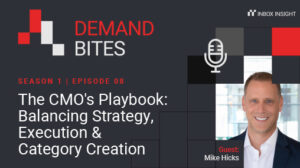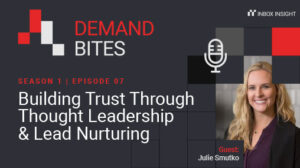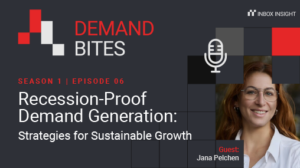With technological advancements continuously changing buyer behaviors and shifting market dynamics, business leaders must stay ahead and adapt their marketing strategies to meet the demands of modern B2B buyers. Failure to embrace new marketing approaches and technologies can leave companies lagging behind, struggling to connect with their target audience, and missing out on valuable opportunities.
By staying attuned to the latest B2B marketing trends this year, marketers can position themselves as industry leaders, deliver exceptional customer experiences, and drive sustainable growth.
B2B marketing trends for 2024 and beyond
Here are some of the biggest trends in B2B marketing based on Inbox Insight’s B2B Tech Buyer Behavior Insights, which surveyed over 800 decision-makers across various industries in the USA and EMEA during the third quarter of 2024.

Embed this image on your site
1. The rise of AI in buyer research and evaluation
A significant trend shaping B2B marketing is the growing influence of AI in buyer research and evaluation processes. As Generative AI, particularly ChatGPT and similar language models, continue to advance, an increasing number of B2B buyers are using these tools to aid their research and decision-making.
Our research shows that nearly half (46%) of B2B buyers now use generative AI tools for research purposes.
AI is not only impacting the research phase but also playing a role in technical evaluations. 38% of buyers trust AI platforms when assessing technical requirements, indicating a growing reliance on these technologies for critical decision-making processes. As AI continues to advance, B2B marketers must adapt their strategies to align with this trend. Incorporating AI-generated content, optimizing for AI-powered search, and leveraging AI-driven personalization will become increasingly important in effectively reaching and engaging B2B buyers.
2. Personalization becomes paramount
As buyer expectations continue to rise, adopting personalization will be crucial for B2B marketers. Almost half (51%) of buyers expect high or very high levels of personalization, while 91% expect at least some level of personalization during the purchasing process. To meet these expectations, B2B marketers should adopt account-based marketing (ABM) strategies. ABM allows companies to tailor their marketing efforts to specific high-value accounts, delivering personalized content and messaging that resonates with each target audience. By aligning sales and marketing teams around a shared understanding of key accounts, ABM enables a level of personalization that would be difficult to achieve through traditional broad-based marketing tactics.
Effective ABM implementation requires a deep understanding of target accounts, including their unique challenges, pain points, and decision-making processes. Utilizing intent data can provide insights into buyer interests and behaviors, helping marketers create highly relevant and personalized content, nurture campaigns, and sales outreach strategies. Additionally, ABM often involves the use of advanced marketing technologies and data analytics to identify and prioritize target accounts, track engagement, and optimize campaigns for maximum impact.
3. Multichannel content distribution
With more users active on various social media platforms, businesses must adopt a multichannel content distribution strategy to effectively reach and engage their target audience. According to our first-party research, B2B buyers are actively present on platforms such as:
- LinkedIn (74%)
- Facebook (57%)
- YouTube (57%)
- X (47%)
- TikTok (32%)
This widespread platform usage underscores the importance of creating content tailored for various formats and channels. Marketing teams can no longer rely solely on traditional channels but must adapt their content strategies to meet buyers where they are. By diversifying their content distribution efforts, including leveraging content syndication, marketers can increase their chances of capturing the attention of decision-makers and influencing their purchasing decisions.
Successful multichannel content distribution requires a deep understanding of the unique characteristics and audience preferences of each platform. For example, LinkedIn may be more suitable for long-form thought leadership pieces, while TikTok could be used for short, engaging videos that showcase a brand’s personality or product demonstrations. Ultimately, a well-executed multichannel distribution strategy enables B2B marketers to maximize their reach, engage with their target audience effectively, and stay ahead of the competition.
4. Email continues to dominate B2B outreach
Despite the rise of new communication channels and marketing tactics, email remains a highly effective outreach strategy.
In fact, 83% of B2B buyers prefer email contact from sellers during the purchasing process.
Email’s dominance can be attributed to several factors. First and foremost, it allows for personalized and targeted communication, enabling marketers to tailor their messaging and content to specific buyer personas and pain points. Additionally, email provides a direct line of communication, facilitating a more intimate and focused dialogue between sellers and potential customers.
Furthermore, email marketing campaigns can be easily tracked and measured, providing valuable insights into engagement rates, click-through rates, and conversion metrics. This data-driven approach allows B2B marketers to continuously refine and optimize their email strategies, ensuring maximum impact and return on investment. While other channels like social media and content marketing have gained prominence, email remains an indispensable tool for marketers. Its ability to cut through the noise, deliver targeted messages, and foster personal connections makes it a powerful asset.
5. Prioritize educational content and thought leadership
As B2B buyers become more discerning, they increasingly expect vendors to provide educational content and thought leadership.
72% of buyers want one-on-one consultations with subject matter experts during their purchasing journey. Additionally, 45% actively seek out thought leadership content from potential vendors.
To create compelling educational content, B2B marketers should focus on providing in-depth insights, expert analysis, and actionable advice. This could take the form of detailed whitepapers, comprehensive guides, or insightful webinars and podcasts. The key is to position your brand as a trusted authority in your industry by sharing valuable knowledge and expertise.
Thought leadership content, on the other hand, should aim to showcase your company’s unique perspectives, innovative ideas, and forward-thinking vision. This could include opinion pieces, industry trend reports, or even interactive tools and calculators that demonstrate your expertise. By sharing thought-provoking ideas and fresh viewpoints, you can differentiate your brand and establish yourself as a leader in your field.
6. Invest time and effort in B2B influencer marketing
Influencer marketing is another trend that B2B marketers should seriously consider in 2024 and beyond.
According to our first-party research, 75% of buyers trust brands more if they are affiliated with industry experts or influencers.
This highlights the importance of working with influential voices within your industry to build credibility and trust with potential customers. Additionally, Ogilvy reports that three-quarters of B2B companies are actively using this strategy, with 40% having reported increased lead generation and sales outcomes as a result.
To start, identify key opinion leaders and subject matter experts in your niche. These individuals should have a strong online presence, a loyal following, and a reputation for providing valuable insights. Collaborate with them to create co-branded content such as guest blog posts, webinars, or social media campaigns. You can also explore opportunities for influencers to endorse or promote your products or services.
When working with content creators, ensure that the partnership is authentic and aligns with your brand values. Influencers should have a genuine understanding and appreciation for your offerings, and their endorsement should feel natural and credible to their audience. Additionally, be transparent about the nature of your partnership to maintain trust with your audience.
By partnering with the right influencers, you can tap into their established networks and benefit from their authority and credibility within your industry, helping you reach new audiences, build brand awareness, and ultimately drive more qualified leads and sales.
7. Emphasis on integration and tech stack compatibility
Today, businesses increasingly rely on various software tools and platforms to streamline operations and drive growth. Consequently, the ability to seamlessly integrate new solutions with existing technology stacks has become a critical consideration for B2B buyers.
According to our research, 90% of buyers prioritize a vendor’s ability to integrate with their current systems and applications.
This emphasis on integration arises from the need for efficiency, data consistency, and a cohesive user experience across various touchpoints. Businesses seek solutions that can effortlessly communicate and share data with their existing systems, eliminating the need for manual data entry, reducing the risk of errors, and minimizing disruptions to established workflows. Additionally, the compatibility of technology stacks plays a crucial role in ensuring a smooth transition and adoption of new solutions. When a vendor’s offering seamlessly integrates with a company’s existing infrastructure, the implementation process becomes more streamlined, reducing the time and resources required for training and onboarding.
As businesses continue to embrace digital transformation and adopt multiple software solutions, the demand for vendor offerings that prioritize integration and compatibility will only intensify. B2B marketers must recognize this trend and highlight their solutions’ ability to seamlessly integrate with industry-standard platforms and popular software ecosystems. Failure to address this need may result in lost opportunities and a competitive disadvantage.
8. On-demand webinars are more popular than ever
A trend gaining significant traction is on-demand webinars. Buyers increasingly seek flexible, self-paced viewing options that align with their busy schedules and preferences.
Nearly half (49%) of B2B buyers engage with webinar content on-demand, underscoring the growing demand for this format.
This trend highlights the importance of creating content that caters to the on-demand preferences of modern buyers. Traditional live webinars, while still valuable, may not always fit the schedules of busy professionals. By offering on-demand alternatives, B2B marketers can ensure their content is accessible and consumable at the audience’s convenience.
Embracing on-demand content requires a strategic approach to content creation and distribution. Marketers should focus on developing high-quality, evergreen content that remains relevant and valuable over time. This content can then be delivered through on-demand platforms, allowing buyers to access it at their convenience. Moreover, on-demand content offers opportunities for personalization and customization. By providing self-paced viewing options, buyers can tailor their content consumption to their specific needs and interests, enhancing engagement and retention.
As on-demand content usage grows, B2B marketers must adapt their strategies to meet the preferences of their target audience. Offering flexible, self-paced viewing options serves the needs of modern buyers and positions brands as innovative and customer-centric, fostering stronger relationships and driving better results.
3 B2B marketing predictions from Ross Howard, Product Marketing Director at Inbox Insight
Ross Howard reveals his top marketing predictions for the B2B industry:
Prediction 1
“We’ve seen a significant shift towards account-based marketing (ABM) strategies that focus on personalized, multi-channel engagement. Marketers will still want to move away from generic, spray-and-pray approaches and instead, focus on building targeted, high-value relationships with key decision-makers and influencers.
However, broadly reaching the account is not enough, and we need to strategically educate the right buying groups to increase momentum and close more deals.”
Prediction 2
“The rise of AI-powered sales intelligence will continue to disrupt the sales landscape. Sales teams will increasingly rely on AI-driven tools to uncover new leads, personalize outreach, and predict buyer behavior. This will enable them to focus on high-value activities like building relationships and closing deals.
The downside is with the potential automation available to everyone now the noise for buyers will increase. Clay workflows and auto-scraping will make personalization easier to the point of not having value. Marketers will need to step in and build brand trust to increase sales likelihood of connecting with prospects and breaking through.”
Prediction 3
“Marketers will need to find new ways to build trust and rapport with buyers, such as through personalized storytelling, empathetic messaging, and authentic, human-led interactions.
We should be looking at how to bring subject matter experts to the forefront of our content to create brand equity through authenticity. Content formats that involve collaboration across vendors and categories with specialists will combine demand generation, thought leadership, and ecosystem-led growth.”
Struggling to connect with your customers? Inbox Insight can help
In addition to staying ahead of the latest digital marketing trends, partnering with B2B demand generation providers like Inbox Insight can drive your growth even further. We specialize in demand generation, focusing on creating and nurturing interest in your products or services. Our strategies are designed to identify potential leads, engage them with tailored content, and guide them through the buyer’s journey.
Through targeted campaigns, data-driven insights, and advanced marketing technologies, our services help you attract high-quality leads, enhance customer engagement, and boost conversion rates. By integrating demand generation into your marketing efforts, you can ensure a steady pipeline of qualified prospects and achieve sustainable business growth.






